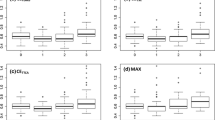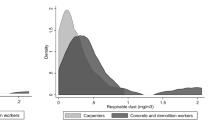Abstract
Objective The aim of the study was to examine whether an increase can be detected in the prevalence of coronary heart disease or a higher prevalence of unusual cardiological findings in workers with occupational exposure to carbon disulphide (CS2) at the level of the threshold limit value of 10 ppm currently valid in occupational medicine. ·Methods In a cross-sectional study we investigated 247 men occupationally exposed to CS2 and a comparable control group (n=222). The current exposure to CS2 was measured using personal air monitoring and biological monitoring of all test persons. A cumulative exposure index (median of CS2 exposure in the past multiplied by the duration of employment) was calculated. In addition to collecting comprehensive anamnestic data on all persons, we carried out a physical examination, an ultrasound examination of the large arteries, a resting and exercise ECG and an echocardiographic examination. ·Results No increase could be found in the prevalence of coronary heart disease or of arteriosclerotic findings in the exposed subjects. There was no difference in the distribution of the performance of the two groups in the ergometric tests. The echocardiogram showed a median increase in the diameter of the left atrium and left ventricle of 1–2 mm in the exposed subjects. These differences could also be confirmed statistically after multiple linear regression analysis. The left ventricular, telesystolic diameter was positively associated (P<0.05) with internal exposure (CS2 metabolite in urine), and fractional shortening revealed a plausible negative trend (P=0.0755). Current external exposure (CS2 in air) and cumulative exposure did not influence any of the parameters investigated. ·Conclusion The findings may indicate a negatively inotropic effect of CS2 so far unknown in man. However, no clinical relevance for this effect was apparent.
Similar content being viewed by others
References
Drexler H, Göen T, Angerer J, Abou-el-ela S, Lehnert G (1994) Carbon disulphide. I. External and Internal exposure to carbon disulphide of workers in the viscose industry. Int Arch Occup Environ Health 65:359–365
Drexler H, Göen T, Angerer J (1995a) Carbon disulphide. II. Investigations on the uptake of CS2 and the excretion of its metabolite 2-thiothiazolidine-4-carboxylic acid after occupational exposure. Int Arch Occup Environ Health 67:5–10
Drexler H, Ulm K, Hubmann M, Hardt R, Göen T, Mondorf W, Lang E, Angerer J, Lehnert G (1995b) Carbon disulphide. III. Risk factors for coronary heart diseases in workers in the viscose industry. Int Arch Occup Environ Health 67:243–252
Hemberg S, Partanen T, Nordman CH, Sumari P (1970) Coronary heart disease among workers exposed to carbon disulphide. Br J Ind Med 27:313–325
Hoffmann P, Klapperstück M (1990) Effects of carbon disulphide on cardiovascular function after acute and subacute exposure of rats. Biomed Biochim Acta 1:121–128
Hoffmann P, Müller S (1990) Subacute carbon disulfide exposure modifies adrenergic cardiovascular actions in rats. Biomed Biochim Acta 49:115–120
Howald H (1981) Herz und Sport, In: Krayenbühl HP Küble W (eds) Kardiologie in Klinik und Praxis, vol 2. Thieme, Stuttgart, pp 54.3
Jadonić B, Wiesner HX (1983) Ein- und zweidimensionale klinische Echokardiographie. Urban und Schwarzenberg, München, pp 30, 285
Kamal AM, Ahmed A, Saied K, Metwall M (1991) Quantitative evaluation of ECG components of workers exposed to carbon disulphide. Environ Health Perspect 90:301–304
Knapikowa D, Andreasik Z, Kwiatowski S, Okrojek M, Smolik R, Szczerba K (1988) Application of the Minnesota Code in evaluating electrocardiographic features of ischemic heart disease in patients exposed to carbon disulphide. Int Arch Occup Environ Health 60:351–353
MacMahon B, Monson RR (1988) Mortality in the US rayon industry. J Occup Med 30:698–705
Sakurai H (1982) A morbidity study of viscose rayon workers exposed to carbon disulphide. Br J Ind Med 39:39–44
Swaen GMH, Braun C, Slangen JJM (1994) Mortality of Dutch workers exposed to carbon disulphide. Int Arch Occup Environ Health 66:103–110
Sweetnam PM, Taylor SWC, Elwood PC (1987) Exposure to carbon disulphide and ischaemic heart disease in a viscose rayon factory. Br J Ind Med 44:220–227
Tolonen M, Nurminen M, Hernberg S (1979) Ten-year coronary mortality of workers exposed to carbon disulphide. Scand J Work Environ Health 5:109–114
Vanhoome M, De Bacquer D, De Backer G (1992) Epidemiological study of the cardiovascular effects of carbon disulphide. Int J Epidemiol 21:745–752
Author information
Authors and Affiliations
Rights and permissions
About this article
Cite this article
Drexler, H., Ulm, K., Hardt, R. et al. Carbon disulphide. Int. Arch Occup Environ Heath 69, 27–32 (1996). https://doi.org/10.1007/BF02630735
Received:
Accepted:
Issue Date:
DOI: https://doi.org/10.1007/BF02630735




